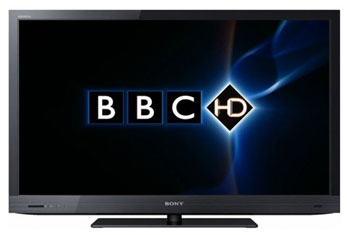A software encoder upgrade for BBC HD on the Freeview HD platform has led to intermittent audio dropouts on some Sony Bravia televisions, the online portal of British home cinema magazine What-Hifi? Sound and Vision has reported. The issue appears to be caused by transitions between 1080p and 1080i high-def broadcasts on BBC HD, and affects Sony’s 2010 and 2011 HDTV models.

It transpired that the Beeb upgraded the encoding software on its Freeview high-definition channels on 22nd and 23rd of March, allowing programmes which are natively shot at 1080p25 to be automatically transmitted in progressive mode instead of interlaced (1080i25). However, since the largely unpublicised upgrade, some owners of Sony TVs have been experiencing frequent sound dropouts on the BBC HD and BBC1 HD channels, presumably as a result of the dynamic switching between 1080p and 1080i materials.
The Japanese TV manufacturer is aware of the problem, and is working hard on a firmware update to ensure there is no disruption in picture and sound data during transitions from progressive to interlaced modes (and vice versa). The timescale given for a fix is between seven to ten days, as the company needs to verify that any adjustments made will be compatible with high-def broadcasts in other countries.
Thus far a similar audio glitch has not been reported on other TV brands, but some viewers have been complaining about the images on screen zooming in and out from time to time when watching BBC HD channels on Freeview HD. This is probably due to the television’s aspect ratio being pegged independently to different video formats, and should be rectifiable by setting the same aspect ratio (ideally without overscan) for both 1080i and 1080p content.
Source: What Hifi

The benefit of switching between 1080p/25 and 1080i is still worth the hassle. Progressive material compresses much more efficient than interlaced.
If the TV detects 2:2, it can WEAVE the fields to recreate the original 1080p25.
So why is BBC switching between 1080i50 and 1080p25? I suppose it will benefit those who don’t own a TV with 2:2 capability.
Technically, it’s actually not switching between 1080i and 1080p at the video processor level. BBC have just described it in this way to make it familiar to most people.
All they’re doing is changing the pic_struct flag in the encoder so that the AVC decoder deals with frames rather than fields. However, the internal design of the TV will likely treat everything as 1080i/50 so it’ll all still go through 2-2 cadence detection.
The benefit here is for compression efficiency.
This sounds like bad news, especially with sports.
At least with i50, it can be bobbed or interpolated to restore some of the source structure.
@David
Not quite. The encoder had MBAFF and PAFF for quite a while so compression efficiency is unchanged. From what I can tell (by the slightly roundabout way they’ve explained it) is that they’re flagging the frames in a progressive GOP as progressive using pic_struct so that the STB outputs at 1080p50 and thus the TV doesn’t deinterlace the progressive footage.
@Kieran K
How is the stb outputting p50 if its transmitted at p25, frame doubling?
@Kieran K – thanks for the clarification! You’re Kieran K from the Open Broadcast Encoder project, right?
So it really is about avoiding deinterlacing/2-2 detection. I wonder how that’ll play out in practice.
@David
Yes, and the x264 Blu-rays etc.
@dans
Presumably frame doubling, but what set top boxes do is a black art at times especially when more and more HD ones are coming from the far east. I guess the reasoning is that 1080p50 is less likely to be modified by the box or TV.
I have a Sony Bravia KDL32V4000.
BBC HD now shows a blank black screen.
Could somebody tell me how to get a picture again. I adjusted it from 22000 to 23000 but to no avail.
John
THIS IS A VERY INTERESTING ISSUE THIS, IN THE WORLD OF HIGH DEFINITION TV. I USE 1080i UPSCALING FOR STANDARD DVDs ON A 19″ 720p TV, AND THE RESULTS ARE IMPRESSIVE. NOW, IF I USE 1080p OR 1080p/24fps FOR STANDARD DVDs, THE TV FLICKERS AND FLASHES CAUSING A VERY FRUSTRATING SITUATION. SELECTING 1080i COMPLETELY RESOLVES THE SITUATION. ON THE SAME TV, SELECTING 1080p OR 1080p/24fps FOR BLU RAY DISCS, CAUSES ABSOLUTELY NO DISRUPTION WHATSOEVER, SO THAT’S THE INTERESTING ISSUE HERE.
I was going to say it’s not just BBC.
But it is BBC HD and BBC channel 1 and 2, so it seems it may be the issue.
Just about to upgrade my KDL-32EX713 from PKG4.092EUL-0108 and see if the dropouts go away …